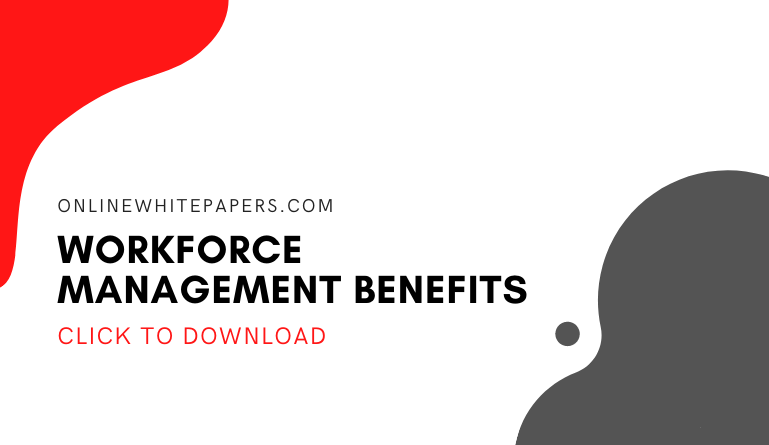When trying to gauge the level of employee satisfaction of a company’s work base, it is imperative to utilize a series of analytic tools to collect numerical based data. Asking the employees directly through opinion forums and behavioral studies have been used in the past to find out what would raise the quality of the work environment. But to gain more concrete answers to potential and underlying problems in the workforce, it is advantageous for employers to explore a more universal approach.
What is workforce analytics?
Workforce analytics is a way of utilizing a formula dependent model to find out whether certain executive policies enacted have produced positive, negative, or moderate results for employees within operations. It also provides a way for the employer to edit and/or replace any procedures that are not serving the best interest of employees as a whole.
Importance of workforce analytics
By implementing workforce analytics when investigating a company’s employee experience, executives and administrators get the opportunity to see the direct impact of how things operate and how they affect the people that work there. To go even deeper conducting workforce analytics may even show how the way a company operates influences the perceptions of the work culture of people who potentially want to be employed there in the future.
What’s the difference between workforce analytics and HR analytics?
Workforce analytics and human resources analytics both deal with employee satisfaction within the workplace. With HR analytics, however, the human resources department assesses how the company as a whole is run and through the results of analytical research determines if operational rules are effective within a multitude of departments from the executive suite, to the middle managers, to the lower-level employees. Whereas workforce analytics, which is run by the Talent Oversight department , focuses only on the employees.
How to apply workforce analytics
-
Hiring
Organize applications for job positions by demographics and research what kind of people are applying for what role and why. Check into the job history and online reputation of job seekers to get an idea of their good and bad behaviors, problematic incidents, and skills.
Breakdown the finalists of the applicants who are most qualified for the job position. Lessen the use of resources by mechanizing and streamlining the hiring process. Be as unbiased as possible by not factoring in traits like race, gender, sexual orientation, etc. in deciding on who will ultimately be hired.
-
Maintaining employees
Manage, notify, and adjust the income rates of overachieving workers who do not necessarily announce the total hours that they are productive. Manage and watch how employees act for safety purposes and to oversee their production levels.
Look into and discuss out of character habits and a sudden drop in productivity as a subtle message by a particular employee that they desire to quit working for the company.
-
Employee oversight
Establish goals for accomplishment and monitor workers’ production levels to estimate how a particular employees can be beneficial to the future of the company through possible promotions. Find weaknesses in onboarding and talent levels in workers to update and enhance operations for the betterment of the workers.
Document high-achieving workers to introduce and guide them in other, more complex duties for the purpose of promoting them in the future.
How to implement workforce analytics
Begin with focusing on a well-known operational issue or inquiry that the company desires to find a solution to. By knowing that a particular organization might have a major problem with the long-term retainment of workers, techniques of workforce analytics can be put into place to find out why employees are not motivated to stay.
Figure out what data mid-level overseers and top-level operators are required to choose what manner of action is best for resolving an issue. In connection to the retaining issue, operators may need to look into how the expectations of the workplace may not match up to what employees were told about the organization during the hiring and onboarding process.
Figure out what the standard will be for solving the issue. After finding out the results of an employee retaining study, the higher ups might want to raise the level of retainment from 50% to 75%. Workforce analytics allows for them to look at how they are currently operating, then as they implement new or adjust old policies, they can see how those percentages change as the pivot happens.
Choose how to break down and record the results. Now the company can see whether its changes in policy within the hiring and onboarding process was successful in increasing the number of employees that are staying with the organization for longer periods of time.
How workforce analytics can benefit organizations
- Have the ability to estimate the amount of production that each worker can perform and how it will impact the quality of operations within a company
- Find the need for innovative ways of operating and challenging roles
- Learn which ways of operating or roles can be switched around or lessened
- Assists to break down and improve monitoring of incentives and paychecks meant for employees
- Find out and put a number to the aspects that affects the recruitment of workers
- Have insight into present-day and subsequent demands
- Enhance the way operations function and the rules are mandated to increase the workers level and quality of production
- Be able to use less resources to run operations
- Assists the organization in finding, helping, and creating proficient workers and potential leaders
- Develop an honest reward apparatus
Examples of workforce analytics in practice
-
Employee oversight
An essential business wanted to know how workers’ production levels on the front line affected sales and consumer perception of services provided. The business wanted to figure out what aspects affected how the consumer needs were met and how much money they made. The information gathered in the study added social and individual behaviors, everyday operational mandates, and consumer contact data.
The results were recorded based on reasons to buy a product and worker onboarding initiatives to find out if a bond was formed between employee and consumer. It turns out how an employee was trained to interact with consumers was the most important factor in determining the quality of relationship between the employee and the buyer, not the amount of money that they made.
The study also showed that behavior type and the amount of time on a shift had an effect on employee/buyer relationships as well. From that point on, the business had better insight into how they mandated their workers and made adjustments to improve their production levels.
-
Keeping employees
Another business wanted to find out what to look out for when a worker is thinking about quitting. From conducting a workforce analytics study, employers found that when words started to distance themselves socially from others around them, there was a higher chance that they were making moves to leave the organization.
By knowing what the warning signs are, employers were able to provide possible incentives for the unsatisfied workers and lessened resignation levels to 25%.
-
Hiring
An international business specializes in creating a workforce analytics feature that produces a questionnaire for job seekers that have recently applied for a role to gather information on applicants’ wants consistent with where they want to be in their career, where they want to advance to, incentives, and level of income desired. Past experiences and skills are also collected.
Businesses can utilize this feature to create better opportunities and benefits attached to a job role to attract more applicants.
Workforce analytics tools
Most workforce analytics tools are offered in software apps and cloud services that:
- Mechanize the gathering of information from various resources and confirms the legitimacy of the information
- Utilized professional workforce date results to breakdown information gathered
- Offers data in easy to follow interfaces, with specialized reports and data boards
- Utilizes probability factors to manage live information gathering
Emerging Trends
- Workforce analytics will go from fixed to live data collecting
- More emphasis will be on employee performance levels
- The well-being of the organization as a whole will outweigh the needs of the individual with “organizational network analysis,” according to an article by hrtechnologist.com.
- Honesty will be centered in workforce analytics
- Focus will shift from people to the workers as a whole
- Innovative features will bridge together standards from workforce analytics to an efficient plan of action
Final Thoughts
Workforce analytics can be thought of as a way for companies to see how the way they operate can affect the people that work with them in an unbiased and numerical way. Math seems to have a way of having information seem more legit and concrete. Although one-on-one, face-to-face opinion forums have their place in knowing how individual employees feel about their work environment, workforce analytics show what works might not always be able to tell.
This leads to a more satisfied, transparent, and long-term workforce. For businesses, this creates an increase of production levels, a better quality of service from workers to consumers, and a better place to work for current and future employees.






